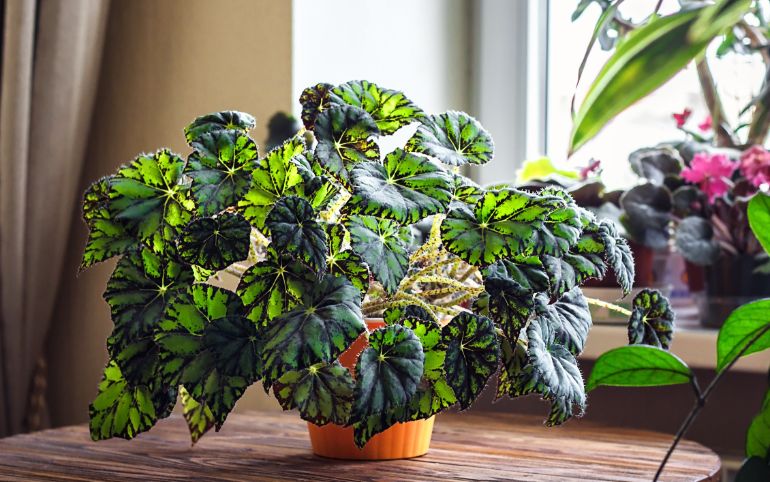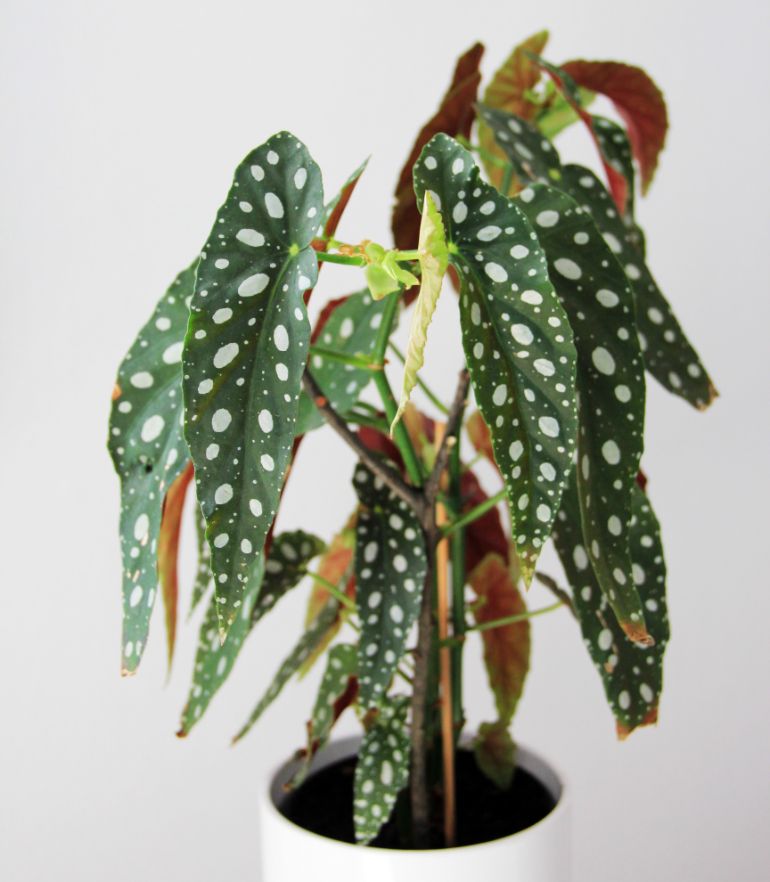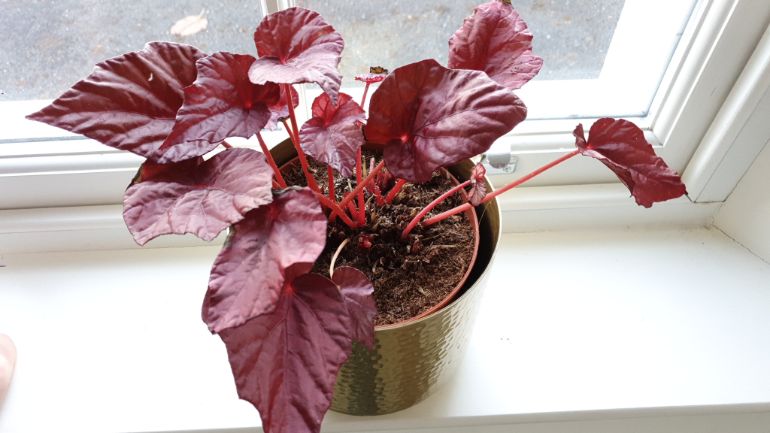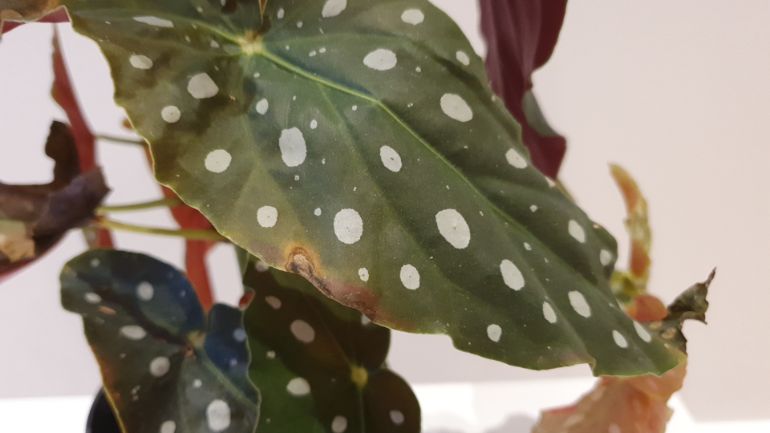Begonias are famed for their stunningly beautiful and widely varied foliage. But such beauty comes at a cost. It can be tricky to keep those leaves looking well, and there are many issues that can result in begonia leaves turning brown. This article will help you work out what is causing the problem, and help you get your plant back to looking its best.
Underwatering and excess direct sunlight are the most common causes of begonia leaves turning brown. Brown leaf tips and edges are usually due to watering problems or low humidity. Brown patches or spots are usually caused by excess direct sunlight or disease.
This article is going to look at each of the causes of brown leaves on begonias to help you identify what the issue is with your plant. This article focuses mainly on popular rhizomatous, Rex, and cane begonias that are commonly grown as houseplants.
7 Causes Of Begonia Leaves Turning Brown
There are two main things to look at to help you work out why the leaves on your begonias are turning brown.
Plant Symptoms – Checking the pattern of browning, along with other symptoms can greatly help to identify the cause of the problem.
Care Conditions – Examining the conditions your begonia has been growing in can usually narrow the cause down further. Looking at the care conditions and plant symptoms together usually helps you identify the correct issue.
If you look close enough, it’s rare not to be reasonably sure why your begonia has brown leaves. Once you know what the problem is, it’s much easier to fix your plant. Let’s look at each cause of brown leaves on begonias to help you work out how to fix your plant.
Underwatering
Underwatering is one of the most common causes of begonia leaves turning brown. If you notice that some lower leaves are crispy and brown, whilst others are developing brown edges or brown tips, then underwatering may be the cause. Lack of water tends to affect both the oldest and youngest foliage first.
Most begonias also wilt quite dramatically when underwatered. While they can usually recover from severe wilting, recurrent or prolonged wilting will usually result in some leaf drop and brown leaves on your begonia.
Here are some things to look for to confirm whether underwatering is causing brown leaves on your begonia;
- The soil feels dry to the touch
- The plant wilts significantly but recovers quickly after watering.
- Brown crispy leaves, affecting edges and tips first.
- Moderate leaf drop, primarily affecting older foliage.
- Slow growth and smaller leaves
How To Stop Begonia Leaves Turning Brown Due To Underwatering
The most important thing to do is to check on your begonia every few days and water it once the top 1-2 inches of soil feels dry. I also like to check the weight of the pot, as it is surprisingly easy to tell just by the weight of the pot when your plant needs watered. Here are some great tips to help you work out when your plant needs water.
There are a number of other things you should check, to make sure your plant is not excessively prone to brown leaves from underwatering.
- Make sure your begonia is not rootbound
- Ensure temperatures are approx 58-72°F (15-22°C)
- Avoid excessive direct sunlight, which can dramatically increase water loss. Most begonias like bright, indirect sunlight.
- Ensure the soil has some moisture retaining properties.

Overwatering
Overwatering is another really common cause of begonia leaves turning brown. Whilst it is the exact opposite of underwatering, it can sometimes produce symptoms that are quite similar to underwatering. You’ll need to look carefully at both the plant and the growing conditions to be sure you are fixing the right problem.
Excessively wet soil prevents soil aeration, and limits acess to oxygen that the roots need to survive. This leads to the roots ceasing to function and can result in root rot.
Initially, when your begonia is given an abundance of water, symptoms such as leaf yellowing and leaf edema are most prominent. Once the roots start to struggle, symptoms of water deficiency start to present in the plant. This causes brown leaf tips, particularly affecting young leaves. It can also result in older leaves turning brown, becoming dry, and dropping from the plant.
As overwatering gets worse, your begonia will start wilting, despite the soil already being wet. If you don’t check your plant carefully and feel the soil for dampness, you could easily mistake the symptoms for underwatering.
Severe overwatering leads to roots rot. This is a very serious problem, and must be treated immediately if you want to have any chance of saving your plant. Read my guide to identifying, treating, and preventing root rot for more info.
How To Prevent Begonia Leaves Turning Brown From Overwatering
Here are some tips to make sure your begonia always gets the right amount of water;
- Always feel the soil to check if the tops 1-2 inches feels dry before watering.
- Lift the pot to check the weight before watering – Wet soil will feel heavy, whilst dry soil feels much lighter.
- Give your plant plenty of light. Begonias kept in low light are much more prone to overwatering, as water use is massively reduced in low light.
- Avoid planting your begonias in excessively large pots. It can take much longer for the soil in a large pot to dry out, increasing the risk of overwatering.
- Always let the pot drain thoroughly after watering. Empty the drip tray after a few minutes to ensure the roots are not sitting in a puddle of water.
Low Humidity
Begonias do best when humidity is kept above 40%, and they can develop brown leaf tips when conditions are too arid. If low humidity is causing your begonia to get brown leaves, the plant will likely be otherwise healthy, except for the unsightly brown leaf tips and margins.
I like to monitor humidity levels in my home to make sure conditions are just right for my houseplants. I use a digital hygrometer that tells me what the current humidity is, along with the maximum and minimum recorded levels since the meter was last reset. This gives me fantastic info to quickly determine whether humidity could be the issue causing my begonias to get brown leaves.
If you live an arid location, or humidity in your home is very low, try one of the following to improve humidity levels.
- Group your houseplants together to create a more humid microclimate.
- Place a humidity tray beside or below your plants (shallow tray filled with water). The increased evaporation can significantly increase humidity levels.
- Put your begonias in a more humid room. Kitchens and bathrooms tend to be more humid.
- Use a humidifier – This is the most effective option, but you do need to keep the humidifier topped up with water every day or two.
- Read my article about increasing humidity for plants for more ideas.
One last point about humidity is to say that excessively high humidity can also cause issues, particularly when ventilation is poor. High humidity increases the risk of fungal and bacterial diseases, which is in turn a cause of brown leaves on begonias. Due to this, try to keep humidity between 40-60% and you should avoid any issues.

Excessive Direct Sunlight
Many types of begonias cannot tolerate strong direct sunlight. Some, such as Begonia maculata can hardly tolerate direct sunlight at all and will develop large brown areas on their leaves, or even entirely brown leaves as they are scorched by the sun.
Those begonias wth more waxy leaves, such as Begonia semperflorens varieties are much more tolerant of direct sunlight, while Rex cultivars can tolerate a modest amount of direct sunlight.
How To Prevent Begonia Leaf Burn
If you think your begonia has brown leaves because of too much direct sunlight, check the lighting levels in your room on several days and at different times of the day. Direct rays of sunlight shouldn’t be falling on your begonia for more than 1-2 hours per day, and ideally only in early morning and late afternoon.
Check the care instructions for your particular begonia and try to match the amount of lighting that is ideal for your plant. Too little light is almost as bad for most houseplants, so aim for a happy medium.
I have a light meter app on my phone that uses the light sensor on my phone to take a reading of light levels near my begonias. I am able to get a quick indication of how bright the conditions are and move my plants closer or further away from the window as needed.
You can get a free light meter app for your phone by searching “light meter app” on the Apple or Google Play stores. I also wrote an article outlining the light requirements of houseplants, so you can use this to judge whether your plants need more or less light.
Acclimation Can Cause Brown Leaves On Begonias
I find begonias to be really fussy when I first bring them home. It isn’t uncommon for begonias to develop quite a number of brown leaves, wilt, and struggle for a few weeks while they acclimate to the conditions in your home.
Make sure to buy really healthy plants at the store, and transport your plants home carefully. When you get them home, try to provide ideal conditions, with temperature, lighting and humidity in the middle of their desired range.
Sometimes the roots of begonias are a little shocked after the stress of the move, and can be prone to root rot if overwatered for the first few weeks.
If you find your begonia’s leaves turning brown within the first few days or weeks, and you’ve made sure to provide good conditions, then just have patience and wait for the plant to recover. Sometimes they can lose a few leaves, and it may take a month or two before new growth develops, but soon your begonia will be looking great again.
Temperature Stress
Begonias seem to be very sensitive to temperature stress at both the lower and upper end of normal. Both can result in brown leaves due to the death of part or all of the leaves. The lower temperature limit for begonias depends on the variety. Fibrous and Rex varieties can generally tolerate temperatures down to 50°F (10°C), whereas cane-stemmed begonias struggle below 55°F (13°C).
Low temperatures cause direct damage to the plants and moderately low temperatures make overwatering problems much more likely.
High temperatures cause rapid water loss from the foliage, causing wilting, brown leaf edges and tips, and even causes entire leaves to turn brown and fall off.
Excess direct sunlight, or positioning your begonias neaxt to a heat source such as a hot air vent or fire appliance can cause major heat stress and brown leaves.
Disease
Begonias are not particularly resistant to disease, so this is definitely something you need to watch carefully for. Diseases will cause rapid development of brown or black leaves on begonias, wilting, and plant death.
Disease is more common in an otherwise stressed plant. High humidity, acclimation, overwatering, and temperature stress can all result in the onset of disease in your begonia.
Look for rapidly spreading irregular brown or black patches or spots on the leaves of your begonia. There is normally no pattern to the browning of the leaves. You may also see entire leaves dying and the plant may wilt quite quickly, despite having sufficiently moist soil.
How To Fix Brown Leaves On Begonias Caused By Disease
The most important thing to do first is to isolate your plant from any others. Diseases can and do spread, so isolating your plant will prevent any others being affected.
Prompt pruning of the affected foliage is the most effective treatment. Whilst this is disappointing, it is very unlikely that the plant can be successfully treated by other means.
The good news is that if you act quickly, you may be able to save your plant. I recently treated one of my Rex begonias in this way. I had to prune off the vast majority of the foliage, but I was able to stop the disease by doing this. It took quite a number of months for the plant to recover, but it looks better than ever now.

Last Word
Whilst it isn’t uncommon to see begonia leaves turning brown, it is normally a simple enough process to find out what the issue is. Bear in mind that there may be several issues contributing to the problem, so you may need to make a few adjustments to make your plant happy.
Begonias can be tricky to keep happy at first, but I find that once they find a place that they are happy in your home, they are usually fairly low maintenance plants. If you’re having any specific issues, you may like to check out the following articles.

